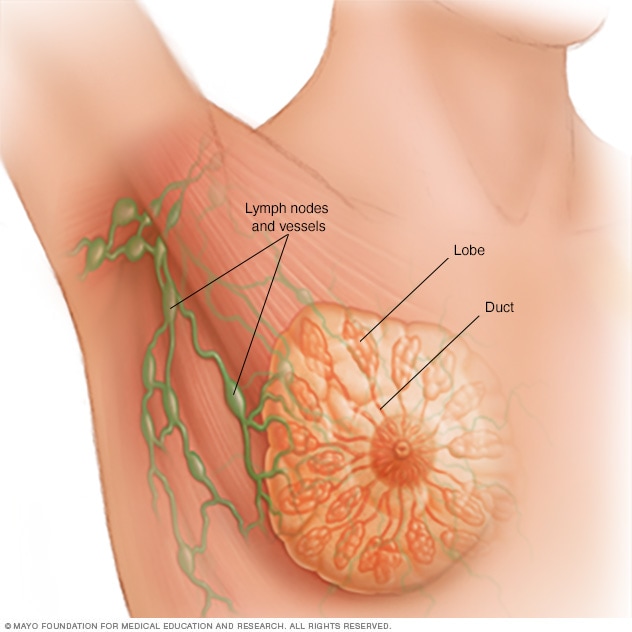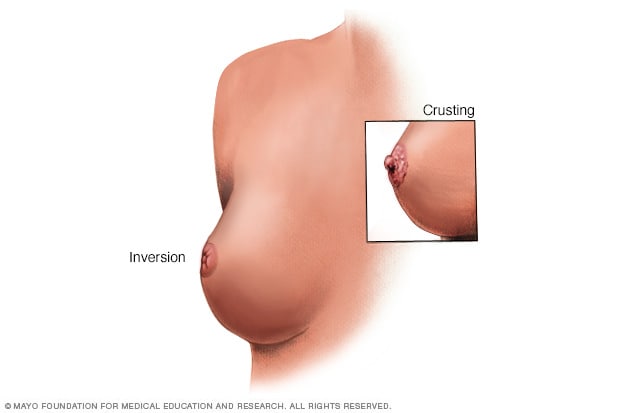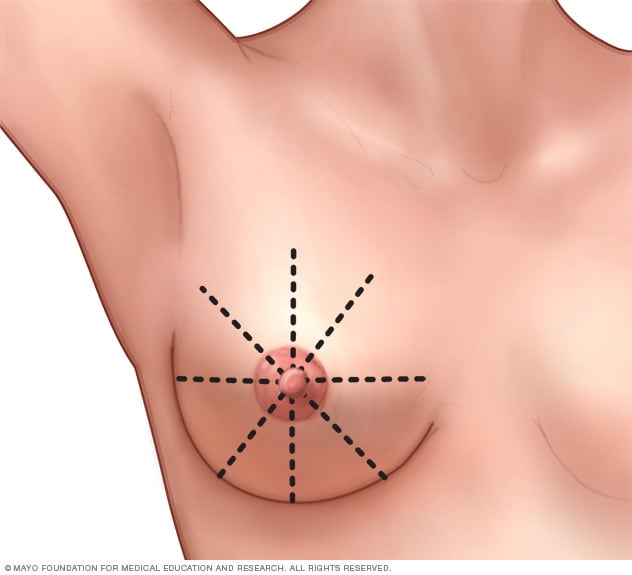Overview
Breast anatomy

Breast anatomy
Each breast contains 15 to 20 lobes of glandular tissue, arranged like the petals of a daisy. The lobes are further divided into smaller lobules that produce milk for breastfeeding. Small tubes, called ducts, conduct the milk to a reservoir that lies just beneath the nipple.
Breast cancer is a kind of cancer that begins as a growth of cells in the breast tissue.
After skin cancer, breast cancer is the most common cancer diagnosed in women in the United States. But breast cancer doesn't just happen in women. Everyone is born with some breast tissue, so anyone can get breast cancer.
Breast cancer survival rates have been increasing. And the number of people dying of breast cancer is steadily going down. Much of this is due to the widespread support for breast cancer awareness and funding for research.
Advances in breast cancer screening allow healthcare professionals to diagnose breast cancer earlier. Finding the cancer earlier makes it much more likely that the cancer can be cured. Even when breast cancer can't be cured, many treatments exist to extend life. New discoveries in breast cancer research are helping healthcare professionals choose the most effective treatment plans.
Types
Symptoms
Nipple changes

Nipple changes
Breast and nipple changes can be a sign of breast cancer. Make an appointment with a healthcare professional if you notice any changes.
Signs and symptoms of breast cancer may include:
- A breast lump or thickened area of skin that feels different from the surrounding tissue.
- A nipple that looks flattened or turns inward.
- Changes in the color of the breast skin. In people with white skin, the breast skin may look pink or red. In people with brown and Black skin, the breast skin may look darker than the other skin on the chest or it may look red or purple.
- Change in the size, shape or appearance of a breast.
- Changes to the skin over the breast, such as skin that looks dimpled or looks like an orange peel.
- Peeling, scaling, crusting or flaking of the skin on the breast.
When to see a doctor
If you find a lump or other change in your breast, make an appointment with a doctor or other healthcare professional. Don't wait for your next mammogram to see if the change you found is breast cancer. Report any changes in your breasts even if a recent mammogram showed there was no breast cancer.
Causes
The exact cause of most breast cancers isn't known. Researchers have found things that increase the risk of breast cancer. These include hormones, lifestyle choices and things in the environment. But it's not clear why some people who don't have any factors get cancer, yet others with risk factors never do. It's likely that breast cancer happens through a complex interaction of your genetic makeup and the world around you.
Healthcare professionals know that breast cancer starts when something changes the DNA inside cells in the breast tissue. A cell's DNA holds the instructions that tell a cell what to do. In healthy cells, the DNA gives instructions to grow and multiply at a set rate. The instructions tell the cells to die at a set time. In cancer cells, the DNA changes give different instructions. The changes tell the cancer cells to make many more cells quickly. Cancer cells can keep living when healthy cells would die. This causes too many cells.
The cancer cells might form a mass called a tumor. The tumor can grow to invade and destroy healthy body tissue. In time, cancer cells can break away and spread to other parts of the body. When cancer spreads, it's called metastatic cancer.
The DNA changes that lead to breast cancer most often happen in the cells that line the milk ducts. These ducts are tubes designed to carry milk to the nipple. Breast cancer that starts in the ducts is called invasive ductal carcinoma. Breast cancer also can start in cells in the milk glands. These glands, called lobules, are designed to make breast milk. Cancer that happens in the lobules is called invasive lobular carcinoma. Other cells in the breast can become cancer cells, though this isn't common.
Risk factors
Factors that may increase the risk of breast cancer include:
- A family history of breast cancer. If a parent, sibling or child had breast cancer, your risk of breast cancer is increased. The risk is higher if your family has a history of getting breast cancer at a young age. The risk also is higher if you have multiple family members with breast cancer. Still, most people diagnosed with breast cancer don't have a family history of the disease.
- A personal history of breast cancer. If you've had cancer in one breast, you have an increased risk of getting cancer in the other breast.
- A personal history of breast conditions. Certain breast conditions are markers for a higher risk of breast cancer. These conditions include lobular carcinoma in situ, also called LCIS, and atypical hyperplasia of the breast. If you've had a breast biopsy that found one of these conditions, you have an increased risk of breast cancer.
- Beginning your period at a younger age. Beginning your period before age 12 increases your risk of breast cancer.
- Beginning menopause at an older age. Beginning menopause after age 55 increases the risk of breast cancer.
- Being female. Women are much more likely than men are to get breast cancer. Everyone is born with some breast tissue, so anyone can get breast cancer.
- Dense breast tissue. Breast tissue is made up of fatty tissue and dense tissue. Dense tissue is made of milk glands, milk ducts and fibrous tissue. If you have dense breasts, you have more dense tissue than fatty tissue in your breasts. Having dense breasts can make it harder to detect breast cancer on a mammogram. If a mammogram showed that you have dense breasts, your risk of breast cancer is increased. Talk with your healthcare team about other tests you might have in addition to mammograms to look for breast cancer.
- Drinking alcohol. Drinking alcohol increases the risk of breast cancer.
- Having your first child at an older age. Giving birth to your first child after age 30 may increase the risk of breast cancer.
- Having never been pregnant. Having been pregnant one or more times lowers the risk of breast cancer. Never having been pregnant increases the risk.
- Increasing age. The risk of breast cancer goes up as you get older.
- Inherited DNA changes that increase cancer risk. Certain DNA changes that increase the risk of breast cancer can be passed from parents to children. The most well-known changes are called BRCA1 and BRCA2. These changes can greatly increase your risk of breast cancer and other cancers, but not everyone with these DNA changes gets cancer.
- Menopausal hormone therapy. Taking certain hormone therapy medicines to control the symptoms of menopause may increase the risk of breast cancer. The risk is linked to hormone therapy medicines that combine estrogen and progesterone. The risk goes down when you stop taking these medicines.
- Obesity. People with obesity have an increased risk of breast cancer.
- Radiation exposure. If you received radiation treatments to your chest as a child or young adult, your risk of breast cancer is higher.
Prevention
Things you can do to lower your risk of breast cancer
Breast self-exam

Breast self-exam
To perform a breast self-exam for breast awareness, follow a pattern that ensures you cover your entire breast. For instance, imagine that your breasts are divided into equal wedges, like pieces of a pie. Move your fingers along each piece in toward your nipple.
Making changes in your daily life may help lower your risk of breast cancer. Try to:
- Ask about breast cancer screening. Talk with your doctor or other healthcare professional about when to begin breast cancer screening. Ask about the benefits and risks of screening. Together, you can decide what breast cancer screening tests are right for you.
-
Become familiar with your breasts through breast self-exam for breast awareness. You may choose to become familiar with your breasts by occasionally inspecting them during a breast self-exam for breast awareness. If there is a new change, a lump or something not typical in your breasts, report it to a healthcare professional right away.
Breast awareness can't prevent breast cancer. But it may help you to better understand the look and feel of your breasts. This might make it more likely that you'll notice if something changes.
- Drink alcohol in moderation, if at all. Limit the amount of alcohol you drink to no more than one drink a day, if you choose to drink. For breast cancer prevention, there is no safe amount of alcohol. So if you're very concerned about your breast cancer risk, you may choose to not drink alcohol.
- Exercise most days of the week. Aim for at least 30 minutes of exercise on most days of the week. If you haven't been active lately, ask a healthcare professional whether it's OK and start slowly.
-
Limit menopausal hormone therapy. Combination hormone therapy may increase the risk of breast cancer. Talk with a healthcare professional about the benefits and risks of hormone therapy.
Some people have symptoms during menopause that cause discomfort. These people may decide that the risks of hormone therapy are acceptable in order to get relief. To reduce the risk of breast cancer, use the lowest dose of hormone therapy possible for the shortest amount of time.
- Maintain a healthy weight. If your weight is healthy, work to maintain that weight. If you need to lose weight, ask a healthcare professional about healthy ways to lower your weight. Eat fewer calories and slowly increase the amount of exercise.
Medicines and operations for those with a high risk of breast cancer
If you have a high risk of breast cancer, you might consider other options to lower the risk. You might have a high risk if you have a family history of breast cancer. Your risk also might be higher if you have a history of precancerous cells in the breast tissue. Talk about your risk with your healthcare team. Your team might have options for lowering your risk, such as:
-
Preventive medicines. Using estrogen-blocking medicines can lower the risk of breast cancer in those who have a high risk. Options include medicines called selective estrogen receptor modulators and aromatase inhibitors. These medicines also are used as hormone therapy treatment for breast cancer.
These medicines carry a risk of side effects. For this reason, they're only used in those who have a very high risk of breast cancer. Discuss the benefits and risks with your healthcare team.
- Preventive surgery. If you have a very high risk of breast cancer, you may consider having surgery to lower the risk of breast cancer. One option might be surgery to remove the breasts, called prophylactic mastectomy. Another option is surgery to remove the ovaries, called prophylactic oophorectomy. This operation lowers the risk of breast cancer and ovarian cancer.
Jan. 10, 2025